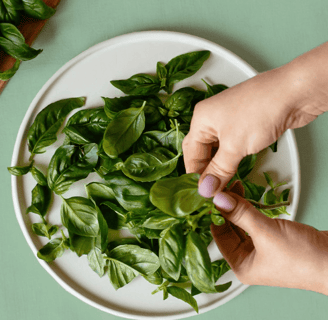How to create a KILLER cooking app using AI !
Dive into the Future Kitchen. Embark on a culinary journey where technology and taste converge, reshaping how we experience the art of cooking through the lens of AI innovation.
Understanding User Preferences and Dietary Needs
The crux of smart ingredient suggestions lies in the app's ability to comprehend user preferences and dietary needs. AI algorithms meticulously analyze user profiles, considering factors such as taste preferences, dietary restrictions, and past ingredient choices. This nuanced understanding enables the app to suggest not only alternative ingredients but also additions that align with individual tastes, creating a tailored culinary experience.
Adapting to Pantry Availability
One of the noteworthy advantages of AI-driven ingredient suggestions is its capacity to help users adapt recipes based on the ingredients available in their pantry. Whether a user is seeking a substitution due to dietary restrictions or needs to replace an ingredient in real-time, the app can offer intelligent alternatives. This adaptability enhances user convenience, encouraging experimentation in the kitchen without being confined to a rigid set of ingredients.
Fostering Culinary Creativity
The feature goes beyond the pragmatic realm of substitutions; it fosters culinary creativity. By suggesting ingredient additions that complement a user's preferences, AI inspires users to explore new flavors, textures, and combinations. This not only expands their culinary repertoire but also cultivates a sense of confidence and innovation, transforming the cooking app into a dynamic culinary partner rather than a static recipe repository.
3. Meal Planning and Grocery Lists
AI-driven meal planning features can take the hassle out of deciding what to cook. By analyzing user preferences, dietary goals, and past choices, the app can suggest personalized meal plans. Additionally, integrating a smart grocery list generator based on chosen recipes streamlines the shopping process, ensuring users have all the necessary ingredients at their fingertips.
Going beyond traditional recipe recommendations, these intelligent systems analyze user preferences, dietary goals, and past choices to suggest personalized meal plans, offering a seamless solution to the perennial question of "What's for dinner?"
Personalized Meal Plans
AI's prowess in data analysis enables cooking apps to curate personalized meal plans tailored to individual preferences and dietary goals. By leveraging machine learning algorithms, the app gains insights into a user's preferred cuisines, preferred meal timings, and nutritional objectives. This personalized approach not only saves users the time and effort of deciding what to cook but also ensures that the suggested meals align with their culinary tastes and health aspirations.
Streamlining the Shopping Experience
An integral companion to AI-driven meal planning is the integration of a smart grocery list generator. Once users select their preferred recipes, the app automatically generates a comprehensive grocery list, ensuring they have all the necessary ingredients at their fingertips when heading to the store. This streamlined approach not only enhances user convenience but also minimizes the risk of overlooking essential items, transforming the grocery shopping experience into a more efficient and organized endeavor.
Adaptive Learning and Continuous Improvement
The dynamic nature of AI-driven meal planning extends beyond immediate user preferences. These systems are designed to adapt and learn from user feedback, refining their recommendations over time. As users engage with the suggested meal plans and provide feedback on their experiences, the AI continuously evolves, becoming more attuned to individual tastes, preferences, and dietary nuances. This adaptive learning process ensures that the meal planning suggestions become increasingly accurate and aligned with users' evolving culinary journeys.
4. Enhanced Search and Discovery
AI algorithms can revolutionize how users discover recipes. By understanding user behavior, search patterns, and preferences, the app can provide more accurate and relevant recipe recommendations. This ensures that users not only find what they're looking for but also discover new and exciting dishes to try. Recommendation engines can increase user satisfaction and engagement by upto 70%.
In today's fast economy, users are accustomed to finding things in seconds. Any app which helps users to find what they are looking for very quickly will win over all others.
Precision in Wine Pairing
Suggesting wine pairings is another useful application. Delving into the realm of culinary delight, the art of suggesting wine pairings is an exquisite facet of gastronomy. Imagine an AI-driven assistant, intricately versed in the nuances of flavors, aromas, and textures, guiding you through a symphony of taste.
Whether it's a velvety red or a crisp white, the AI sommelier effortlessly elevates your dining experience. With a vast repertoire of wine knowledge and an innate understanding of culinary alchemy, this technological marvel becomes a trusted companion ensuring each sip and bite harmonize in a blissful duet.


Unleashing the Power of AI in Cooking Apps
In a world increasingly driven by technology, the culinary landscape is no exception. Cooking apps have become indispensable tools for home chefs, offering a plethora of recipes, step-by-step guides, and kitchen inspiration. However, to truly elevate the user experience and scale a cooking app effectively, integrating Artificial Intelligence (AI) can be a game-changer.
The AI in Food & Beverages Market size is estimated at USD 9.68 billion in 2024, and is expected to reach USD 48.99 billion by 2029, growing at a CAGR of 38.30% during the forecast period (2024-2029).
It is a fragmented market with five key players but no clear leader: TOMRA Sorting Solutions AS, Rockwell Automation Inc., ABB Ltd, Honeywell International Inc. and Key Technology Inc. [Source]
This article explores the key strategies to scale a cooking app using AI, unlocking new dimensions of efficiency, personalization, and innovation.
1. Recipe Personalization
The Recipe Apps Market size was valued at USD 342.10 Million in 2020 and is projected to reach USD 1,098.22 Million by 2028, growing at a CAGR of 13.24% from 2021 to 2028 [Source].
Free Users dominate the market share and are expected to experience the highest growth rate. According to App Annie's recent list of the top-grossing iPhone apps in the U.S., only 9 out of 100 apps are purely paid, while 91 out of the top 100 apps are available for free download. "Word of mouth" organic advertising remains the most effective marketing method, contributing to 98% of global app revenue from free apps [Source].
When contemplating a cooking app, consider this statistic: Android stands out as the most widely used operating system globally, boasting over 2.5 billion active users across 190 countries. Numerous surveys indicate that Android devices contribute to more than 70% of the total mobile phone sales share [Source].
AI can transform a cooking app into a personalized culinary assistant. By leveraging machine learning algorithms, the app can analyze user preferences, dietary restrictions, and past interactions to recommend recipes tailored to individual tastes. This not only enhances user engagement but also fosters a sense of connection and loyalty.
AI-Powered User Profiling
AI-driven cooking apps initiate the personalization process by creating comprehensive user profiles. These profiles encapsulate a user's culinary preferences, dietary restrictions, and historical interactions within the app. Through continuous learning, the AI refines these profiles over time, ensuring that recommendations align closely with individual tastes.
Analyzing User Preferences
Machine learning algorithms play a pivotal role in analyzing and deciphering user preferences. These algorithms consider various factors, such as flavor profiles, cooking styles, preferred ingredients, and even the time of day a user typically engages with the app. This nuanced understanding enables the AI to curate recipe suggestions that resonate with the user's unique palate.
Accommodating Dietary Restrictions
Recipe personalization extends beyond taste preferences to accommodate dietary restrictions. Whether a user is vegetarian, vegan, gluten-free, or has specific allergens to avoid, AI can filter and tailor recipe recommendations accordingly. This level of customization ensures that users with diverse dietary needs can still enjoy a personalized and delightful cooking experience.
Recipe personalization enhances user engagement by providing tailored suggestions that align with individual tastes, fostering a strong connection and loyalty to the cooking app. This contributes to a seamless cooking journey, simplifying the entire culinary process and making the app a trusted companion for users.
2. Smart Ingredient Suggestions
Implementing AI to suggest ingredient substitutions or additions based on user preferences and dietary requirements adds a layer of intelligence to the app. This feature not only accommodates individual preferences but also helps users adapt recipes to suit their dietary needs or the ingredients available in their pantry. This functionality goes beyond mere recipe guidance, empowering users to adapt and customize recipes based on their individual preferences and dietary requirements.


5. Image Recognition for Ingredient Measurement
Simplify the cooking process by incorporating AI-powered image recognition for ingredient measurement. Users can take a picture of their ingredients, and the app can accurately estimate quantities, providing a seamless and efficient cooking experience.
This innovative feature leverages AI algorithms to analyze images captured by users, providing not only a visual representation but also accurate estimations of ingredient quantities. This transformative capability streamlines the cooking process, offering users a new level of convenience and precision in their culinary endeavors.
Seamless Cooking Experience
AI-powered image recognition for ingredient measurement revolutionizes the way users interact with recipes. By allowing users to capture images of their ingredients through the app, the technology interprets the visuals and estimates the quantities needed for the recipe. This eliminates the need for traditional measuring tools and reduces the risk of inaccuracies in ingredient proportions. The result is a seamless cooking experience where users can focus on the creative aspects of preparing a dish without the interruptions of meticulous measurement.
Efficiency and Accessibility
The incorporation of AI-driven image recognition not only enhances the efficiency of the cooking process but also increases accessibility for users of varying culinary expertise. Beginners benefit from the intuitive visual aids, gaining confidence in their ability to replicate recipes accurately. Experienced chefs, on the other hand, appreciate the time saved and the precision afforded by this technology.
6. User-Generated Content Moderation
As cooking apps encourage users to share their creations, implementing AI for content moderation ensures a positive and safe community environment. AI algorithms can automatically detect and filter inappropriate or unsafe content, maintaining the integrity and reputation of the app.
7. Continuous Learning and Improvement
AI's self-learning capabilities enable the app to continuously evolve. By analyzing user feedback, interactions, and emerging culinary trends, the app can adapt and refine its recommendations, ensuring that it stays at the forefront of the culinary landscape.
Challenges & Considerations
Privacy and Data Security:
As cooking apps collect and analyze user data for personalization, privacy concerns become paramount. Implementing robust privacy measures and ensuring transparent communication about data usage are crucial for building and maintaining user trust.
Avoiding Over-Personalization:
While personalization is beneficial, there's a fine line between offering tailored suggestions and over-personalization. Striking the right balance ensures that users receive relevant recommendations without feeling confined to a narrow range of options.
Summary
In the age of technology, integrating AI into cooking apps is not just a step forward; it's a leap toward transforming the culinary experience for users.
The ability to personalize, recommend, and adapt based on user preferences empowers cooking apps to scale their impact and cater to a diverse and dynamic audience. As developers and innovators explore the vast possibilities AI brings to the kitchen, the future of cooking apps holds exciting prospects for culinary enthusiasts worldwide.
By embracing the potential of AI, cooking apps can transcend their traditional roles, becoming indispensable companions on the journey to culinary excellence.
If you would like some help building an AI driven system that solves the entire problem for your business, talk to us.
Click here to schedule an AI strategy call now.


Contact us
Whether you have a request, a query, or want to work with us, use the form below to get in touch with our team.
